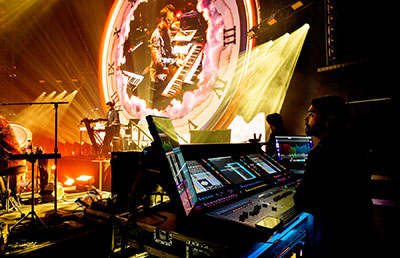Having spent much of 2025 on the Wonderment Tour of the world, AR Rahman’s FOH engineer Riyasdeen Riyan and monitor engineer Mark Thomas have benefited from their use of Fourier Audio’s transform.engine, a host server that runs VST3 plug-ins with extremely low latency. Both engineers paired it with Fourier’s transform.suite ’25 software bundle on their respective DiGiCo Quantum338 consoles.
 Known to fans as ARR, composer, musician, record producer, singer, songwriter and philanthropist Allahrakka (AR) Rahman is best known for his scoring of Tamil and Hindi cinema, as well as international film work that has earned him two Academy Awards, six National Film Awards, a pair of Grammy Awards, a BAFTA and a Golden Globe.
Known to fans as ARR, composer, musician, record producer, singer, songwriter and philanthropist Allahrakka (AR) Rahman is best known for his scoring of Tamil and Hindi cinema, as well as international film work that has earned him two Academy Awards, six National Film Awards, a pair of Grammy Awards, a BAFTA and a Golden Globe.
The Wonderment Tour visited cities across North America and the UK, including Vancouver, Los Angeles, Houston, Atlanta, Toronto, Manchester and Birmingham. Most recently, his show hit home in Hyderabad, Pune and Mumbai.
Thomas says that he and Riyan discovered the transform.engine online, via social media: ‘We heard about it and then secured a demo unit before we went on tour,’ he recalls. ‘We were looking for a way to transition from Waves to a third-party platform, which would support third-party plug-ins and beyond. The transform.engine fit the bill perfectly. And now, over the course of the entire tour, both of us have completely adopted it into our workflows. It was that transformative.’
Riyan reports success in using many plug-ins through the transform.engine – including Oeksound Soothe Live, LiquidSonics’ Seventh Heaven and Cinematic Rooms bundles, Gullfoss Live, and SoundToys’ Crystallizer and EchoBoy – but its biggest advantage for him has been in the workflow department, and specifically for achieving a studio-level processing quality.

‘We can replicate live whatever effects that we are using in studio,’ he says. ‘Whomever the artists are that we are working with, including AR, they are mostly from the studio world, and now we can replicate whatever they used in their original sessions, easily and reliably.’
Riyan reckons that this extends granularly to each plug-in’s various parameters – ‘the kind and tempo of delay, the kind of effects, or the robotic vocals, or the harmonies… everything’ – that allows them to recreate the studio experience onstage.
Thomas, who is also using a DMI-Klang immersive IEM mixing system card on the shows, is applying the transform.engine primarily for his Valhalla and LiquidSonics reverb plug-ins, as well as the Oeksound Soothe Live dynamic resonance suppressor, which is part of the transform.suite ‘25 bundle that he inserts on his console’s mix bus. But the main ‘transformative’ aspect of the transform.engine for him is in the workflow.
‘The major change that has happened is that the sonic quality I previously wanted with using these plug-ins depended upon using a server,’ he explains. ‘With the transform.engine, I can load up exactly the plug-ins that I need and have the flexibility of using them with time-code synchronisation, so virtually zero latency.’
That’s critical for Rahman’s complex shows, he says, due to the large number and frequency of the snapshots needed.
‘We have a lot of changes in the plug-ins’ parameters, which the transform.engine handles very well,’ he says. ‘And the coordination of the plug-in host within the video environment allows us to tweak settings on the fly without going into a third-party screen. So the workflow is quite very fast and flexible, compared to most other plug-in workflows that we’ve previously used. It really is transformative.’
More: www.arrahman.com

